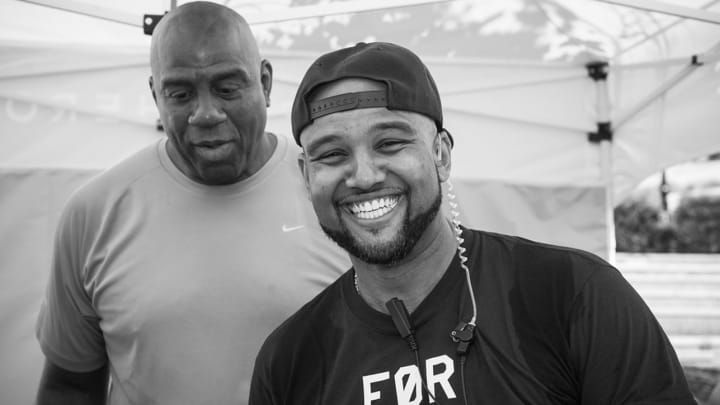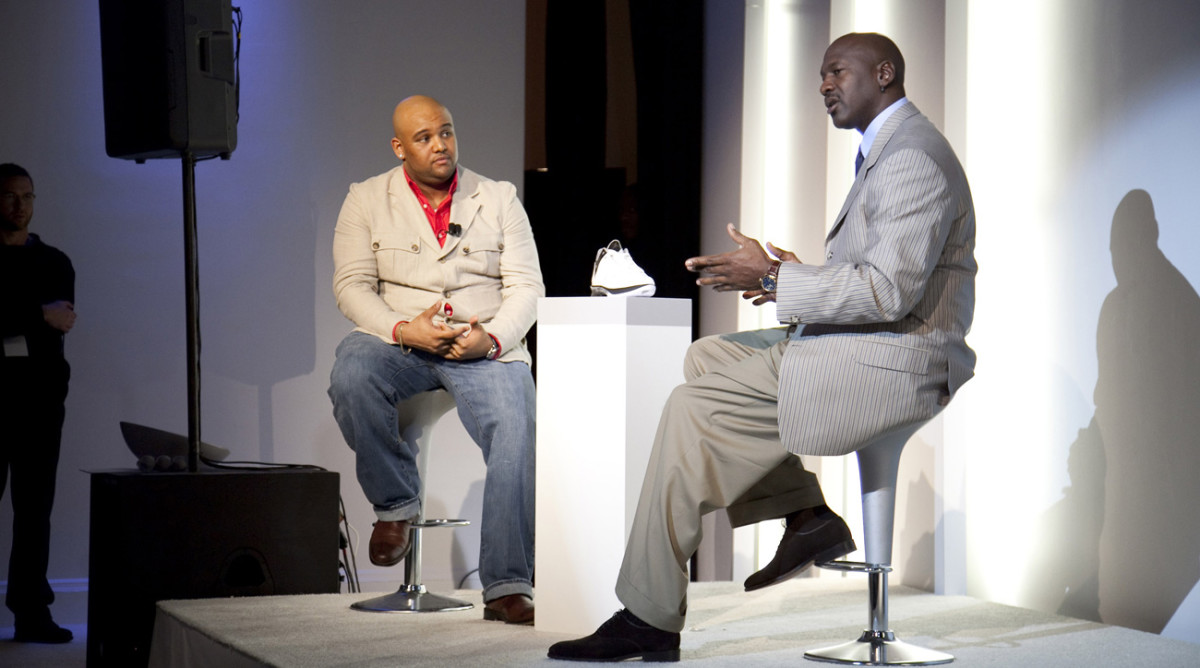Jason Mayden Q&A: The Story of a 'Super Heroic' Sneaker with a Cause

Jason Mayden stood inside Michael Jordan’s bathroom and realized his dream had finally come true. Mayden, at the time, was a burgeoning sneaker designer in the midst of a sneaker presentation who couldn't wait to call his parents to share his whereabouts.
Mayden, a Chicago native, was Jordan Brand’s first design intern. He climbed his way up the ranks to become the brand’s lead designer. There, Mayden had the opportunity to create products for Carmelo Anthony, Chris Paul, Russell Westbrook, Derek Jeter and, of course, his Airness. After a 13 year career at Nike and Jordan Brand, Mayden set out on a new path following a conversation with his then seven-year-old son, who was crying because of his with weight issues. Mayden quit Nike and began working on Super Heroic—a brand that is reinventing the way children play through sneakers and apparel. With the backing of investors in Silicon Valley and Magic Johnson, the company created its first-ever performance shoe, the TMBLR V1, which was designed specifically for the playground.
The Crossover had the opportunity to chat with Mayden about growing up in Chicago idolizing Jordan, designing sneakers, the full bathroom story and his plans for Super Heroic.
(This article has been edited and condensed for clarity)
Jarrel Harris: You grew up in Chicago during the Michael Jordan reign. What was your experience growing up in the city?
Jason Mayden: Growing up in Chicago on the South Side was probably the most informative part of my life. Because it allowed me to understand the importance of narratives, the importance of the strength of my community, but most importantly the importance of strength of knowledge itself. The people that surrounded me quoted to me daily that who I am was enough and what I can do is limitless despite where came from or what I looked like. I was surrounded by art, music, sports and entrepreneurship and so many different encouraging narratives that you often don't see when you hear about the South Side of Chicago. I feel like I have a unique advantage growing up in the city because it prepared me for so much more than even I knew I was prepared for.
JH:Chicago gets a bad rep for its violence and all the events that end up on the news, but it also boasts some of the most creative people in culture today, such as yourself, Kanye West, Chance the Rapper, Dwayne Wade, and Hebru Brantley. What is it about Chicago that makes it this hub for creativity?
Mayden: Well, if you look at its history and the founding of the city itself, the city was at the epicenter of the great migration so we had the best and brightest talent—so specifically black people moved to the South Side and moved to the West Side at the same time. So there is a mashup of entrepreneurial spirit because of music, performing arts, spoken word and there is just this hustle that comes from the factories and this blue-collar culture. People from my generation and my neighborhood just don't have a sense of quit. We knew it was going to be hard but we sought out challenges and knew every move we made was a multigenerational move and about the next people. It’s something in the water man. A mosaic culture. No one from the Chi is short of words. We all have the ability to speak well because we were encouraged to read and articulate ourselves to tell stories. And that is what we are seeing in today's young generation of men and women who were given a voice at an early age and never actually fell victim to being told our voice didn’t matter.
Montrezl Harrell Q&A: This Clippers Forward Is Coming for the Sneaker Crown
JH: Where did your love for sneakers originate?
JM: It was in the fourth grade, my classmate came in with military blue Air Jordan IV’s and I was so blown away because her whole outfit was coordinated from the beads in her hair down to her sneakers. Just that outfit architecture alone was impressive. I was just a kid but seeing how that whole outfit and how she coordinated it, I just knew I had to be a part of it. I got in trouble because the teacher thought I was staring at her but I was like, 'Nah, I am staring at the shoes (laughs).' I risked it all in that moment. That is when I fell in love.
JH: Growing up in Chicago, how much influence did Michael Jordan have on your life and career?
JM: One-hundred percent influencing in my early days. Michael Jordan was the first true super hero. I was fortunate because my father played pickup ball in Chicago all of the time and I had the opportunity to see MJ play pick-up ball before I saw him play in the league. He was Bruce Wayne and Batman all in one. So being a big comic book fan and a geek of the culture, I wanted to be Luscious Fox. I wanted to be the gentleman that designed that gear for that man, and if I can be great enough in my craft, one day I can design for Michael Jordan because he was a real life superhero to me. He gave me confidence to speak about my dreams because he conducted himself in interviews with eloquence and style. I learned about fashion, culture because of the cars he drove, the clothes he wore, it was just special. He introduced us to a world outside of Chicago by simply letting us see his lifestyle and that changed a lot of our perspectives. Walk downtown, take the train and go to Michigan Ave. and we just hoped MJ would come out Armani. We didn't know what Armani was until MJ told us. We were able to dream bigger because of his lifestyle.

JH: How has being a black designer in the sneaker business affected you? Were there times when you felt that companies weren’t giving a chance because of your skin color?
JM: I think that is always ever-present, but for me I don’t allow anyone to make me feel less than because of my skin color. I know my worth in this industry. You will always have obstacles. I think it is honestly harder for women. I have spent more time advocating for fair treatment for women in the industry. While I can say things have happened, I honestly can't say that I have had any difficulties because of my race. But I have seen my female colleagues go through challenges. I think for us in this industry it is heavily male dominated. It is incredibly competitive and we need to figure out ways to look at our differences as our greatest strength. It can be an obstacle for some but I wasn't brought up to be spiritually or intellectually shackled.
JH: You went to Europe to learn about crafting leather and storytelling through sneakers. You went to Asia to learn about manufacturing. How have these experiences helped you?
JM: Man, you did your research. That's awesome. They helped me tremendously. What I did was created a curriculum for myself. I knew that in order for me to really understand my craft, I first had to respect and understand the history and the heritage. So in my 20’s I made a deliberate choice to forgo big salaries to experience and travel and I wanted to learn. I feel that knowledge is the currency that never fades in terms of value. When I went to Europe I learned how they made leather, treated letter and I learned how it was distributed. So I had that appreciation because I saw how many steps it took to make it the way it looked. It gave me a different perspective on crafting and the small details. In Asia what I saw was this understanding that in order for me to design the best possible product I have to consider how many hands touched the product and learning how to be efficient. I simplified how I designed from manufacturing and seeing how things are being made. I humbled myself. I don't know everything so I seek out experts till this day and learn from them.

JH: What was it like working on your first design for Jordan? What were the sneakers and can you describe the thoughts that was going through your head?
JM: There are two stories. The first one is when I was an intern and I designed the Air Jordan 17 ‘Mule’, which is a slip on post game shoe and it happened by accident. I just made a pair for myself and people around the company kind of saw what I was doing and I told them the story. I was overcome with emotion when I actually saw it went into production and it sold out. It is amazing.
But my first real chance designing an Air Jordan was in 2009 and I was extremely nervous because this is the moment I dreamed about my entire life. My first presentation was to Michael in his home in Chicago and I walked in and I immediately went to stand in his trophy room, which was like the court inside the Chicago Bulls arena and I just got nervous. I said ‘Excuse me, may I use your restroom?’ And he allows me to go to the restroom and I go to the restroom and I call my mom and I'm like, 'Mom he has Jumpman towels in his bathroom. This is crazy’.
I didn't realize I was in the bathroom for about 20 minutes and just imagine being in someone's bathroom for 20 minutes on the phone. It can be an awkward experience. So he realizes finally that I'm on the phone with my parents so he says, ‘Do me a favor, tell your parents I said hello and wash your hands when you come out the bathroom.’ So I walk out and I'm embarrassed. He had this smile on his face and gave me a hug and said, ‘I understand it, I understand why you called your parents. You should be proud. I know how far you have come and I know what you have been through’.
I thought he was upset but honestly that was his way of just taking a moment and helping me to calm down because he knew that this was my dream my entire life and I was finally living it. He wanted to make sure I felt comfortable and gave me a moment to express my emotions and not pretend that I have been there before. But it was fun man. Till this day I still crack up. I spent 20 minutes in Michael Jordan's bathroom on the phone with my mom but I would do it all over again.
JH: You also had a hand in the ultimate dad shoe, the Nike Air Monarch. The sneaker is a favorite to get clowned on now but honestly, where does it rank for you?
JM: (Laughs) That shoe is honestly the reason why my career took off. It was a project nobody wanted and at the same time I was doing the branding for Michael Vick, so I was stuck in between two worlds. One was this crazy and emergent cultural icon, he was a phenom just coming out of Virginia Tech and I was fortunate to help him with his footwear and it was crazy. And then I got a project that no one wanted and that was this white leather shoe for J.C. Penny. And I put the same amount of energy and care into that product because I knew that shoe was for the everyday hero. The high school football coach, the dad that works in factories, or the grandfather that picks you up after school and walks you home.
So I focused on celebrating these men and fathers that we often overlook because they are not athletes but they are performing. And everyone clowned me because I took so much care and I put so much effort into the shoe. Mr. (Phil) Knight and the leadership at Nike saw that and saw the effort and they rewarded me by giving me the opportunity to return to Jordan so I can work with professional athletes. I tell everyone excellence is the small things you do consistently over the time. I pulled myself into this small project and it gave me the biggest impact of my career.
JH:What is crazy is that dad shoes and the Monarch are in style now. Are you mad about the recent acceptance in culture? Are you like, 'Where was all of this when we first released these'?
JM: Honestly, man, it doesn't really change much for me because I saw the numbers reflect the interest. The Monarch is the second-highest selling shoe in the footwear industry. To see the impact, to see the faces and people wearing it everywhere I go, I always felt that it was cool. Because the people who I designed them for loved it and now that I see the culture picking up on it and everyone is rocking the chunky dad sneakers I kind of chuckle because we talked about this 15 years ago when we first worked on it in 2002. We honestly joked about this shoe becoming a fashion icon. So every design has its time, every product has its moment and it's just funny after 15 years of commercial success now it's being culturally accepted. It's pretty cool.
(Watch the video above to learn about the origins of Super Heroic)
JH: Magic Johnson came on as an investor in Super Heroic. How is the experience working with him and what are some things he in saw in this business?
JM: It's been a very humbling experience. I met Magic when receiving an award from an educational organization in Chicago and he saw me and my passion for the youth and he was the first person to say that Jason is going to own a shoe company one day. This is two years before I actually founded Super Heroic. He has given me a lot of advice and the support. Just like how he has been the president of the Lakers, he he been like a player/coach for Super Heroic because of the personal advice he has given me and helping me navigate this next level in my career. He has been very instrumental and very helpful.
JH: What is your ultimate goal for Super Heroic and what can we expect later from you guys?
JM: What we hope to build is a mobile hybrid experience where children can physically wear the product and play. Our vision is way bigger if you can't tell than footwear and apparel. Our goals is building a system and a platform through play and getting children to the playground.
